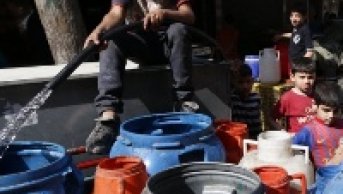Water Problem in Iran Reaching Dangerous Levels

With Iran's population growing each passing day and dry spells in the country in recent years, projections indicate that a water problem will prevail in Iran and the country will have problems meeting its demand for water in the coming years.
After former Iranian Minister of Agriculture Issa KSalantari's statement last week, the gravity of the water-resource problem Iran will confront was brought to the fore. Kalantari said that Iran could turn into a desert in the next 30 years. Excessive use of groundwater has led to a decline in groundwater levels, and groundwater won't be able to recharge due to a lack of precipitation. Along with Lake Urmia, which is frequently on the agenda because it is drying up, the drying of lakes Bakhtegan, Tashak, Parishan and other small lakes indicates the severity of the situation.
Iran is located in one of the most arid regions of the world and has an area of 1.64 million square kilometers. Its annual average precipitation is 252 millimeters. This is about a third of the global precipitation rate. Under current climatic circumstances, 179 millimeters of that -- some 71 percent -- of rainfall evaporates in Iran. The average annual evaporation rate in Iran ranges between 1,500 and 2,000 millimeters. Differences of both latitude and altitude in the country's geography and major climatic differences affect the current situation. Also, precipitation rates differ across the country.
The amount of renewable water in Iran is about 130 billion cubic meters. In addition to worsening drought, population growth has led to a decline in the country's water per capita. Total water consumption in Iran in 1963 was 4.44 billion cubic meters. Water consumption hit 83 billion cubic meters in 1993 and 93.36 billion in 2006. While available water per capita was 7,000 cubic meters in 1956, it dropped to 2,160 cubic meters in 1996 and to 1,900 in the last decade. One of the most important sectors of the national economy is agriculture, and the water scarcity restricts the development of this sector. Due to efforts toward self-sufficiency in food production, Iran allocates 90 percent of its water resources to agriculture.
Iran has striven to solve its water problem, which is more prevalent in certain parts of the country due to the unequal distribution of water resources through interbasin transfers and the unequal distribution of water demand. Besides, Iran has been building a great number of dams to meet country's water needs. Iran has become a world leader in dam construction in recent years. Iran started building dams in the 1950s.
According to ICOLD (International Commission on Large Dams), 501 dams have been built so far since 1950 in Iran. Since 2011, 135 dams have been built, and 546 dams are planned to be constructed.
According to information obtained from Iran's Energy Ministry, the country's dams held 61 billion cubic meters in late 2011. This is twice the annual potential flow of the Euphrates River. Last summer, the Iranian deputy minister of energy said that 130 dams were under construction, 700 dams were in operation and -- despite the figures above -- that Iran ranked fourth in the world for total dams. Feasibility studies for 170 dams are underway.
According to statements from the Alborz Integrated Land and Water Management Project in Iran, population growth, insufficient investment and mismanagement are creating problems for the sustainable management of water resources. According to the calculations of the Iranian government, which witnessed several dry spells in a row in recent years, available water per capita will be 1,300 cubic meters in 2020. Furthermore, salt-carrying dust storms that originate in both Iran and neighboring countries harm the quality of the country's water and soil.
In regions where water resources are lacking, water scarcity and excessive water loss are caused by the mismanagement of water resources. Global studies point out the need for changes to irrigation methods and the development of modern irrigation techniques like drip irrigation and sprinkling to mitigate water loss and make irrigation more efficient and productive. Moreover, the Global Trends 2030 report estimates that precipitation rates in Iran will drop at a rate of 15.6 percent by 2050. Dam construction, interbasin water transfer and other measures are insufficient to eliminate Iran's water problem. Reforms in water-resource management in accordance with new climatic conditions must be made.






